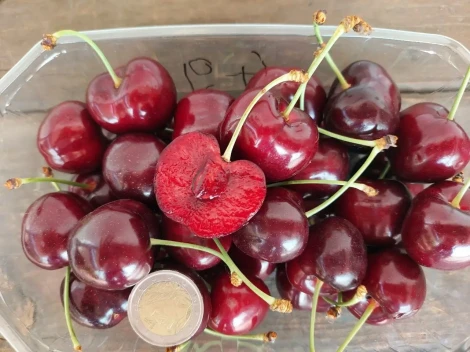Trade in China goes beyond simple commercial transactions. It is an art that combines human relationships, symbolism, and a deep cultural understanding. This article explores how these dimensions, rooted in Chinese values, offer a path toward sustainable success in a complex and dynamic market.
In January 2025, the Chinese market for Chilean cherries suffered a drastic drop in prices due to an oversupply during peak season. This phenomenon highlights the dynamics of a demanding market where strategic decisions must consider not only supply and demand but also cultural particularities. Based on this reality, we present an analysis that connects Chinese values to opportunities in the fruit trade.
Patience: time as a strategic resource
Patience, or 耐心 (Nàixīn), is a central virtue in Chinese culture. In this context, time is seen as a strategic resource that allows relationships to be cultivated, contexts to be analyzed, and actions to be taken at the right moment. The strategy of 韬光养晦 (Tāoguāng Yǎnghuì), which means “hide your light and nurture darkness,” emphasizes the importance of building solid foundations before seeking visible results. In this sense, the oversupply of Chilean cherries in January 2025 reflected a disconnect between production and the cycles of the Chinese market.
By failing to align shipments with periods of high cultural demand, such as the Lunar New Year, prices dropped, negatively affecting both the perception and positioning opportunities of the product.
The Western mindset tends to prioritize quick results, with a focus on short-term goals. While efficient in some contexts, this perspective contrasts with the long-term Chinese vision, which seeks sustainable impact and follows the market’s natural rhythms.
Lesson for the industry: Integrating strategic patience means planning shipments and marketing strategies in line with Chinese cultural cycles. This not only stabilizes the market but also positions Chilean cherries as a premium product during key festivities.
Guānxi: networks as intangible capital
In Chinese culture, 关系 (Guānxi) is much more than business relationships; it is a system of mutual trust and reciprocity developed over time. These networks not only connect people but are essential for accessing key information and forming strategic alliances.
In a context where no consolidated Chinese brand represents Chilean cherries, Guānxi becomes a fundamental tool to build a strong and culturally resonant narrative. In the West, business relationships tend to be more transactional, which can limit adaptability in markets like China, where personal networks carry significant weight.

Lesson for the industry: Cultivating Guānxi allows exporters to understand the nuances of the market, form alliances with key players, and build a brand that connects with local consumers. This not only strengthens the position of Chilean cherries but also opens new opportunities in a competitive market.
By flooding the market, Western exporters stripped the product of its symbolic aura.
Symbolism: beyond the product
In China, fruit is not just food; it is a carrier of cultural meanings. Cherries, or 樱桃 (Yīngtáo), symbolize prosperity and good fortune. Oranges, or 橙子 (Chéngzi), represent luck and happiness. Grapes, or 葡萄 (Pútáo), evoke wealth and longevity. These values are deeply woven into traditions like the Lunar New Year, when gifts carry auspicious meanings.
The price drop in January 2025 underscored the importance of emotional connection with consumers. The absence of a cultural narrative highlighting the symbolism of Chilean cherries leaves a gap that can be filled through creative strategies.
The West often treats fruit as standardized commodities, focusing on technical attributes like quality and price, without delving into the cultural values that surround them. This may limit emotional engagement with Chinese consumers.
Lesson for the industry: Integrating symbolic elements into packaging and brand storytelling can turn Chilean cherries into a symbol of prosperity and cultural connection. Designing campaigns aligned with traditional holidays and using auspicious colors like red and gold are key steps to differentiate the product.
Building a sustainable future in the Chinese market
The fragmentation of the Chilean cherry market in China offers a unique opportunity. The absence of a consolidated Chinese brand allows exporters to create an identity that deeply connects with local consumers. This void is not a limitation but a fertile ground for innovation.
The collapse in Chilean cherry prices revealed a critical disconnect between Western strategies and Chinese cultural values.
China does not just buy products—it buys the meanings and emotions they represent. That’s why the West must show a genuine interest in understanding the deeper motivations driving purchasing behavior in China, turning that understanding into strategies that address the collective psychology and cultural values shaping this market.
China is not just a market; it is a cultural ecosystem that demands understanding and respect. Building a brand that goes beyond transactions to resonate with local values and traditions is the way to position Chilean cherries as a symbol of prosperity and connection in the Asian giant.
Success is not about shipping more boxes or lowering prices, but about interpreting and respecting the cultural fractals that govern consumption. Chilean cherries must evolve from being a commodity to a powerful symbol—one that represents not only prosperity for Chinese consumers but also the West’s commitment to their culture and values.
With a strategy that combines strategic patience, symbolic enrichment, Guānxi building, and a sincere interest in Chinese culture, Chilean exporters can not only recover the premium perception of cherries but also establish a symbiotic and sustainable relationship with this market.
Source: latinoamerica.visionmagazine.com
Fiorella Bonino
Expert on the Chinese market and founder of ChinaExpert
Cherry Times – All rights reserved













